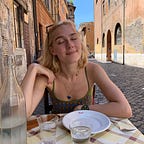A Short Review of Kehinde Wiley: The Prelude at the National Gallery, London
Written March 2022
Positioned between European 16th- and 17th-century portraits, works by Jordaens and Gainsborough, in the Central Hall of the National Gallery is the entrance to the Kehinde Wiley exhibition, the Prelude. The Sunley Room has been split: one corridor-like space exhibits five paintings, leading visitors to a darkened room where a six-channel film plays continuously. The exhibition is a continuation of Wiley’s 2017 exhibition, In Search of the Miraculous at the Stephen Friedman Gallery, in its painted depictions of black people in traditional Western seascapes and its multi-channel film depicting black people among nature. A quotation at its entrance calls a viewer’s attention to “The relationship between man and nature.”
But Wiley’s assertion that “nature itself is a protagonist” is complicated upon viewing the paintings. Wiley’s painted figures are placed in strong juxtaposition with their backgrounds, with a poignant imbalance between human protagonist and natural “protagonist”. This is most evident in painting style, as the figures are rendered photo-realistically while placed within backgrounds indicating little attention to detail, most surprisingly the unfinished leaf outlines in Prelude (Ibrahima Ndiaye and El Hadji Malick Gueye). In addition, the figures are color-graded differently to their background, notable in Prelude (Babacar Mané) as the greenish studio-lighting that illuminates the figure is not shared by his scene’s warm sunlight. The intention of style in these works is hard to discern as Wiley outsources an undisclosed amount of painting to a workshop in Beijing, but their twofold impact is clear on the viewer. In one facet, Wiley’s works make clear the distance between black people and the Western art historical canon; by design of colonialism and racism, they do not fit the settings created by Géricault, Homer, or Friedrich. In another facet, there is a possibility for loss of emotional interest as the paintings give an impression of dispassionate photoshopping — a digital, algorithmic quality estranging the viewer.
A continuation of this loss of emotional depth in the paintings is the relationships between the figures themselves. As the models seem superimposed on their backgrounds, they also seem superimposed together, occupying different spaces in a way that creates awkwardness rather than solidarity between people. Ship of Fools II exemplifies this lack of emotional intensity in the relationships between figures and with nature: the figures all stare into different areas within space, evidently photographed separately, in intense studio lighting atop a background with little attention to the drama that could be created by rendering the sea and sky with any detail. The scene, like The Raft of the Medusa, should represent solidarity and invoke pity for peoples facing certain peril at sea as they scream, some drowning. Instead, the viewer feels apathetic, unable to imagine these figures facing any life-threatening situations save the intensity of studio lighting. Perhaps, this calls attention to the heartless way we view black suffering or the suffering of migrants in the media. Perhaps, it calls attention to the potential for emotion that Wiley does not quite achieve through paint.
The filmwork is the exhibition’s apex where Wiley leaves behind dispassionate superimposing in favor of filming on location in Norway. It has genuine emotional depth, from the elation provided by the giggling of women playing patty-cake to the exploitation associated with watching six men try to hold a smile for as long as possible or stand shirtless in a snowstorm. It deals with themes of solitude and solidarity, from people trudging through the snow alone to sitting by a campfire together. All of this is punctuated by an original score by Niles Luther that swells and retreats spectacularly while beautiful poetry by Ralph Waldo Emerson and William Wordsworth is read aloud. The film truly encapsulates the Sublime.
So, what is the “relationship between man and nature” presented in Wiley’s Prelude? According to the paintings, the relationship is discordant, but not in a way that makes a great impact on the viewer. But after viewing the film, the viewer can understand a more complex thesis: nature as at once in harmony with and at odds with man just as people are at once in harmony with and at odds with each other. This relationship, mirroring the relationship between blackness and the canon, is fraught with a mix of elation and exploitation.
Works cited
Quotation from Kehinde Wiley from exhibition description at entrance, viewed 15 March 2022.
Exhibition catalog, p. 84.
Beam, Christopher. “Kehinde Wiley’s Global Reach: “Outsource to China”” New York Magazine, 20 April 2012, https://nymag.com/arts/art/rules/kehinde-wiley-2012-4/. Accessed 16 March 2022.
